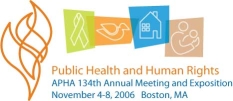 Back to Annual Meeting
|

|
 Back to Annual Meeting
|
APHA Scientific Session and Event Listing |
 Back to Annual Meeting
|

|
 Back to Annual Meeting
|
APHA Scientific Session and Event Listing |
Amanda M. Adams, BA1, Ted D. Nirenberg, PhD1, Janette Baird, PhD2, Michael J. Mello, MD, MPH1, and Richard Longabaugh, EdD3. (1) Injury Prevention Center, Rhode Island Hospital, 110 Lockwood Street, Suite 334, Providence, RI 02903, 401-444-2685, amanda_adams@brown.edu, (2) Injury Prevention Center, 110 Lockwood Street, Room 334, Providence, RI 02903, (3) Center for Alcohol and Addiction Studies, Brown University, Box G-BH, Brown University, Providence, RI 02912
Objective: The Reducing Youthful Dangerous Driving (RYDD) program is a court-mandated program for youthful (ages 16-20 years) traffic offenders to reduce their risk of a motor vehicle crash. The purpose of this analysis was to understand the prevalence of alcohol and drug use among participants without a previous alcohol-related conviction. Method: Between 2001 and 2004, 303 participants completed the RYDD program. Participants were grouped as having an alcohol-related traffic conviction or not in the 12-month period before RYDD. Self-report measures in both groups at baseline included demographics, AUDIT and Drug Use Questionnaire. The main outcomes were alcohol use, problem alcohol use and drug use. Results: Of the 303 participants in this study, 53.1% had not received an alcohol-related traffic conviction in the year prior to RYDD. As expected, this group had significantly lower rates of alcohol use (p = .0008) and alcohol problems (p = .0001). However, their prevalence rates of alcohol use within the last three months (79.4%), drug use within the last three months (50.3%) and alcohol problems (45.6%) were considerably larger than expected. Conclusion: This study found that participants who entered into the RYDD program without a prior alcohol-related traffic conviction reported unexpectedly high rates of alcohol and drug use. This finding highlights the usefulness of screening for alcohol and drug use in adolescents who are convicted of any traffic related offense.
Learning Objectives:
Keywords: Injury Prevention, Adolescent Health
Presenting author's disclosure statement:
Not Answered
The 134th Annual Meeting & Exposition (November 4-8, 2006) of APHA